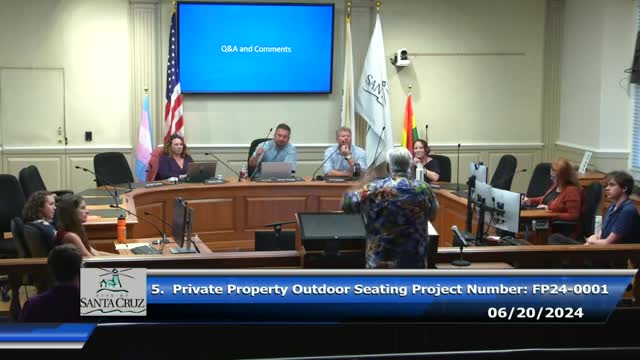City urged to rethink outdoor dining regulations to save restaurants
June 22, 2024 | Santa Cruz City, Santa Cruz County, California

This article was created by AI summarizing key points discussed. AI makes mistakes, so for full details and context, please refer to the video of the full meeting. Please report any errors so we can fix them. Report an error »

During a recent government meeting, significant discussions centered around the regulations governing outdoor dining spaces in Santa Cruz, particularly the implications of a proposed 300 square foot limit for such areas. The meeting highlighted concerns from local restaurant owners and community members regarding the potential negative impact of these regulations on small businesses that have relied on outdoor dining to survive the challenges posed by the COVID-19 pandemic.
One speaker emphasized that the 300 square foot threshold is insufficient for many establishments, arguing that it restricts their ability to serve customers effectively. The speaker noted that this limitation could force restaurants to incur costly renovations, including the installation of additional restrooms and compliance with updated building codes, which many small businesses may not afford.
Patrice Boyle, owner of La Posta, shared her experience of adapting to outdoor dining during the pandemic and expressed frustration over the city's requirement for new building permits for spaces exceeding 300 square feet. She urged city officials to consider extending the outdoor dining program until 2026, in line with state law, and to explore more flexible regulations that would support local businesses.
Another speaker, Endo Brennan, a retired downtown commission member, argued against the arbitrary nature of the 300 square foot limit, suggesting that the city should examine the Fremont ordinance, which allows for a 750 square foot outdoor dining area. He pointed out that Fremont's approach has been successful and could serve as a model for Santa Cruz.
The meeting concluded with a call for creative solutions to support the local dining scene, with several speakers advocating for a collaborative approach between the city and restaurant owners to ensure the survival and growth of these vital community businesses. The discussions underscored the importance of balancing regulatory compliance with the economic needs of local establishments, particularly in a post-pandemic landscape.
One speaker emphasized that the 300 square foot threshold is insufficient for many establishments, arguing that it restricts their ability to serve customers effectively. The speaker noted that this limitation could force restaurants to incur costly renovations, including the installation of additional restrooms and compliance with updated building codes, which many small businesses may not afford.
Patrice Boyle, owner of La Posta, shared her experience of adapting to outdoor dining during the pandemic and expressed frustration over the city's requirement for new building permits for spaces exceeding 300 square feet. She urged city officials to consider extending the outdoor dining program until 2026, in line with state law, and to explore more flexible regulations that would support local businesses.
Another speaker, Endo Brennan, a retired downtown commission member, argued against the arbitrary nature of the 300 square foot limit, suggesting that the city should examine the Fremont ordinance, which allows for a 750 square foot outdoor dining area. He pointed out that Fremont's approach has been successful and could serve as a model for Santa Cruz.
The meeting concluded with a call for creative solutions to support the local dining scene, with several speakers advocating for a collaborative approach between the city and restaurant owners to ensure the survival and growth of these vital community businesses. The discussions underscored the importance of balancing regulatory compliance with the economic needs of local establishments, particularly in a post-pandemic landscape.
View full meeting
This article is based on a recent meeting—watch the full video and explore the complete transcript for deeper insights into the discussion.
View full meeting
